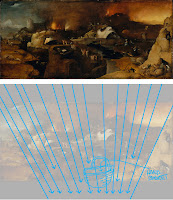“So when Aaron and all the sons of Israel saw Moses, behold, the skin of his face shone, and they were afraid to come near him.” – Exodus 34:30
I don’t profess to be a Theologian, and I’m certainly no linguist. You won’t find Greek or Hebrew lexicons on any of my library shelves. I have a ton of English dictionaries on the same shelves, but those are a testament to what might be considered a deficiency in my command of the language. Meh. I digress.
 |
| “St. Jerome in the Wilderness,” by Bernardino Pinturicchio. c. 1480. (The Walters Art Museum, Baltimore) |
When it comes to interpreting Holy Scripture, I rely heavily on pastors who can decipher the clarity of The Word as it has been written by inspired hands. I’ve been told there are words foreign to me that don’t translate well into English, and that goes for some found in the original Greek and Hebrew texts of Scripture. This is starting to sound like a recipe for disaster, isn't it?
Once in a while, a bad translation slips past the proofreaders, then breezes under the noses of theologians and finally gets signed off by a pontiff. Once in a greater while, worlds collide and that little goof gets handed off like a virus to another discipline. Such was the case in 382 A.D., when St. Jerome was at the translating helm, and such was the case when the Council of Trent (1545-63) finally put a seal of approval on the same translation – just in time for Renaissance artists to go running off with it. Dopes.
 |
| “Moses,” by Michelangelo. c. 1513-1515. (Church of San Peitro in Vincoli, Rome) |
First, let’s back up and pay a little visit to Jerome. The guy’s mug could be found all over the place in the art world, pointing to the fact that he was venerated and placed on a pretty high pedestal. His biggest achievement, aside from hanging out in caves and doing the hermit thing, was translating the Bible into Latin for the bigwigs in the Vatican. His translation is known to us as the Vulgate.
For our sakes, that little, original word, when transliterated into English, is “karan.” That word has its root in another transliterated word, “keren.” Of course neither of these words mean a thing to me, and that’s where linguists in general and Bible scholars in particular come into play. Jerome was then at bat – in Mudville.
 |
| “Well of Moses (detail),” by Claus Sluter. 1395-1403. (Musée Archéologique, Dijon, France) |
St. Jerome, when applying “keren” to the prophet Moses, traveled down one path of possibilities and translated the word as “horned.” [Face-palm] He should have chosen the path less traveled. Today, the same is translated as “shining” or “emitting rays.”
During the Renaissance, however, the Vulgate was THE translation. Messing with it could mean a little trip to the chopping block and a return trip, sans head. Artists, being prudently dutiful, were faithful to the translation, obedient to the Holy See, and captive to silliness. Thus, we have inherited a herd of famed prophets – sporting horns. Some look like elderly Pans, some look like Hellboy and some look like Satan himself. It’s embarrassing.
Let’s start with the big guns of Michelangelo. You can almost hear his version of Moses belting out the familiar strain, “I am Moses, hear me more, with horn-things too big to ignore.” Sit down Moses. Oh, you ARE sitting.
 |
| “Moses,” by José de Ribera. 1638. (Museo di San Martino, Naples, Italy) |
Next up is Moses from Claus Sluter’s “Well of Moses.” If anyone out there is keeping score, I really, REALLY like Sluter’s piece, which is handsome enough to warrant its own blog post. But Sluter’s Moses has Hellboy genes, for sure – it’s probably Hellboy’s dad, Hellpops.
To be fair, translating light into a solid is always a nightmare for sculptors. A nimbus, for example, always looks like a dinner plate when affixed to a sculpted head. 2-D artists, however, have no such excuse.
Painters tried hard to nail that ambiguous Hebrew word and often wound up with a pair of headlights on old Moses. I suppose we should be thankful the artists used only two rays of light, avoiding the tri-radiant treatment reserved for Persons of The Holy Trinity. José de Ribera painted Moses as the Mothman, with a couple of feathery, shiny, horn, uh, things. We’ll give José an “E” for effort.
 |
| “Moses with His Arms Supported by Aaron and Hur,” by Thomas Brigstocke. 1840-1860. (Aberystwyth University, Wales) |
Unfortunately, some things are very hard to unlearn. Thomas Brigstocke’s “Moses with His Arms Supported by Aaron and Hur,” stuck with the headlights motif way after the Renaissance fact. But by the looks of it, Moses has had enough already.
It really is a pity that we’ve inherited this mess of errant art that mirrors a poorly translated bit of the Inerrant Word. If St. Jerome had only taken greater care with the original text, he would have set the art world on a much different path of esthetic expression, and that would have made all the difference.















